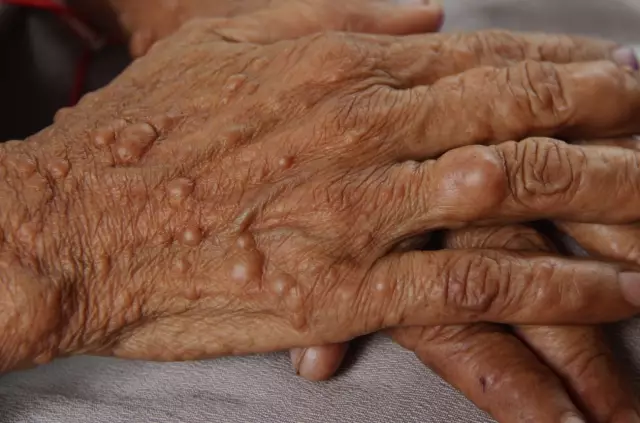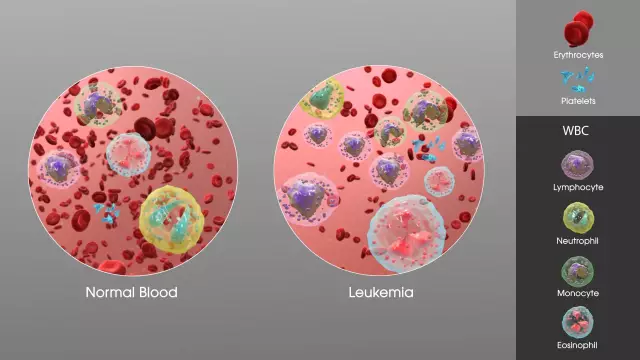- Author Rachel Wainwright [email protected].
- Public 2023-12-15 07:39.
- Last modified 2025-11-02 20:14.
Neurofibromatosis
General characteristics of the disease

Neurofibromatosis (or Recklinghausen's disease) belongs to a specific group of pathologies - phakomatoses. Such a pathology is caused by a metabolic disorder in the body as a whole, which is caused by damage to a gene responsible for the synthesis of an important enzyme. This disease affects many organs and even entire systems. Malformations of the skin, nervous system, eyes, internal organs, etc. are possible. Thus, neurofibromatosis is a phakomatosis with significant skin lesions.
Outwardly, it is a set of spots on the skin of a coffee-milk color, neurofibromas and pigmented hamartomas of the iris (Bream nodules).
Diagnosis and prescribing appropriate treatment for neurofibromatosis is complicated by the fact that this pathology is not fully understood. Doctors cannot attribute this disease to any one branch of medicine, because a number of organs are affected, and all kinds of tumors develop on the skin. I must say that their appearance also has no clear medical explanation and, unfortunately, there are no methods of prevention.
Causes of neurofibromatosis
We can unequivocally say that neurofibromatosis in 50% of cases is a genetically hereditary disease that affects all neural crest cells, without exception: Schwann cells, lemmocytes, melanocytes and endoneural fibroblasts.
As a result of the multiplication of their cellular elements, a tumor forms throughout the body. The disease neurofibromatosis is the cause of malfunctioning of melanocytes, which leads to the appearance of unreasonable age spots and other disorders in pigmentation.
The tumor can appear in the form of subcutaneous bumps, colored spots, problems with the skeleton, possibly affecting the bases of the spinal nerves and the occurrence of other neurological problems.
Neurofibromatosis means that even if only one copy of the defective gene is inherited, the disease will still develop. If one of the parents has a damaged gene, then his children will inherit a 50% chance of developing this disease. The severity of the disease depends on the level of gene expression.
However, the cause of neurofibromatosis in the second half of all known cases is the result of spontaneous mutation, i.e. heredity was not the deciding factor. It is impossible to say who suffers from this disease more often, men or women, the statistics are the same.
Neurofibromatosis in children is most often a congenital form, because cases of acquired disease occur in older age.
Types of neurofibromatosis
There are six types of the studied forms of neurofibromatosis:
The main (classical) first type is the disease known as von Recklinghausen's disease. This is the most common form and occurs in 90% of cases.
Type II neurofibromatosis (mixed) in its characteristics is quite close to the first type, but skin defects are less noticeable, and the main symptoms are the manifestation of an auditory nerve neuroma and signs that indicate inflammatory processes of neuroma in the brain or spinal cord. At the age of 20-30, a tumor may develop in the central nervous system. This type of neurofibramatosis disease is characterized by the presence of soft but large age spots, as well as a large number of neurofibromas in the palms.
Type III neurofibromatosis is characterized by the presence of multiple cutaneous neurofibromas, which can cause optic glioma, meningioma, and neurolemma.
Type IV (segmental) neurofibromatosis affects only one specific area of the skin.
Type V neurofibromatosis is characterized by the complete absence of neurofibromas, only pigment spots are present.
Type VI neurofibromatosis is distinguished by its late manifestation (in the form of the appearance of neurofibromas) after the age of 20, and is most often acquired.
Symptoms of neurofibromatosis
By itself, the disease neurofibromatosis does not have clear symptoms, and its manifestation in each patient is individual. Possible plexiform neuromuscular, optic gliomas, or acoustic neuromas. But most often there is a malignant transformation of the neuromuscular nerve, the result of which is neurofibrosorcoma.
The causes of neurofibromatosis can cause mental abnormalities, but do not cause serious mental illness. This is due to the pressure of the formed tumor on the nervous system. Possible neurofibromatosis in children against the background of the development of macrocephaly (an increase in the brain, proceeding with mental retardation), which develop into epilepsy. These sick children are also at risk of developing leukemia.
The external symptoms of neurofibromatosis (in the form of bumps, spots, etc.) look very unpleasant, and it is rather difficult for the patient to adapt in society, to find contact with others.
Neurofibromatosis treatment

Radical methods of therapy for such a disease simply do not exist, so the treatment of neurofibromatosis is symptomatic.
Specialists prescribe drugs that contribute to the normalization (at least partial) of disturbed metabolic processes. The course of treatment and the specific method are completely individual, and depend on the results of examinations not only by a geneticist, but also by an orthopedist, neurologist, oncologist, ophthalmologist, etc.
There are known cases of the development of a tumor that provokes the appearance of other diseases and has an increased danger to the patient. Therefore, for the treatment of neurofibromotosis in such cases, several surgical operations are performed. Depending on the location of the tumor, a gamma knife may be used.
If a person with neurofibromatosis begins to deaf, then an operation is performed to decompress tumors in the zone of the vestibular cochlear nerve.
As a prophylaxis for the disease, neurofibromatosis is recommended to conduct medical and genetic consultations.
YouTube video related to the article:
The information is generalized and provided for informational purposes only. At the first sign of illness, see your doctor. Self-medication is hazardous to health!






